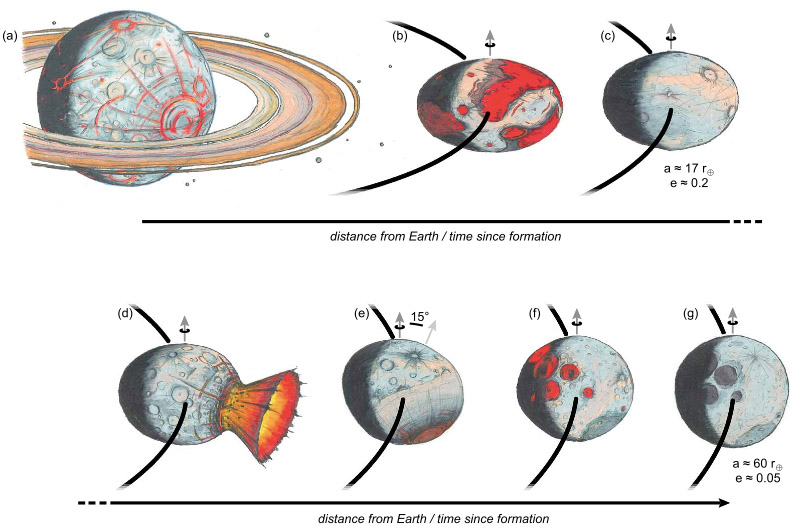Difference between revisions of "November 27, 2014"
| Line 16: | Line 16: | ||
<p><b>Tomorrow's LPOD:</b> [[November 28, 2014|A Final Bow]] </p> | <p><b>Tomorrow's LPOD:</b> [[November 28, 2014|A Final Bow]] </p> | ||
<hr /> | <hr /> | ||
| + | {{wiki/ArticleFooter}} | ||
Revision as of 17:49, 7 February 2015
Knocking the Moon Over

image from Keane and Matsuyama, 2014
The Moon's bulges, due to its rotation and tides raised by the Earth, are larger than can be explained by the Moon's current orbital distance and rotational period. Thus, it has long been suggested that the bulges were frozen into place early in its history when the Moon was much closer to Earth, orbited it much faster, and had a higher eccentricity (a less circular orbit). But the currently favored Big Splat theory of the Moon's formation yields a ring of debris that would be in the Earth's equatorial plane and with zero eccentricity. The two theories conflict. A new idea proposes a solution. Using GRAIL's detailed model for lunar gravity, Keane and Matsuyama have stripped out the influence of the mascons and ejecta blankets associated with lunar basins to derive a gravity figure that represents the pre-basins shape of the Moon, right after it was formed. The resulting bulges are much smaller than ones observed today and could form with the Moon in a non-eccentric orbit, as expected from the Big Splat model. Their analysis further shows that nearly all of the contribution to the Moon's present figure is due to the ejecta from South Pole - Aitken Basin (SPA). Keane and Matsuyama propose that the collision that formed the SPA Basin reoriented the Moon, tipping it 15° compared to its spin axis. The diagram above illustrates the proposed sequence that formed the Moon's fossil bulge. The Big Splat collision formed rings around Earth (a) that quickly coalesced to form the early Moon (b). Because of tidal interaction with Earth, the Moon moved away from the Earth, its magma ocean cooled (b) and the crust finally cooled, freezing in the fossil bulges (c). The SPA collision (d) knocked the Moon over 15° so that the SPA Basin is closer to the south pole (e). Subsequent basin formation and mare flooding (f) occur, and the Moon continues to move outward to its present distance at 60 Earth radii (g). In this model, SPA formed very early, when the Moon was about 18 Earth's radii away. Dating the formation of SPA will lead to refinement of the history of the migration of the Moon away from Earth.
Chuck Wood
Related Links
Keane, J. T., and I. Matsuyama (2014), Evidence for lunar true polar wander and a past low-eccentricity, synchronous lunar orbit, Geophys. Res. Lett., 41,
6610–6619, doi:10.1002/2014GL061195.
Yesterday's LPOD: Nicholas Times Two
Tomorrow's LPOD: A Final Bow
COMMENTS?
Register, Log in, and join in the comments.



